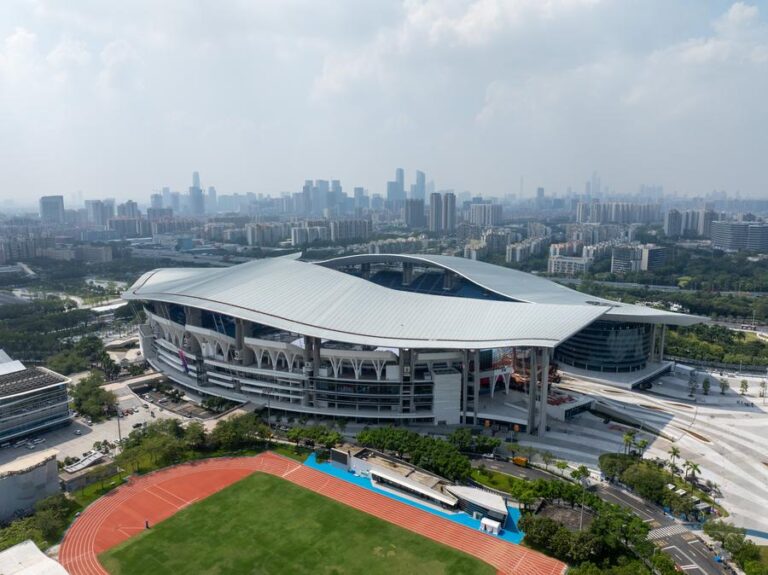China’s 15th National Games, co-hosted by Guangdong, Hong Kong and Macao, will officially open on Nov. 9, symbolizing unity and shared development.
Smart technology has been adopted across the host cities. In Guangzhou, more than 300 autonomous vehicles are used for venue shuttles and sanitation services, while the Hong Kong Police Force employs drones for 3D venue mapping to support precise deployments.
As a symbol of traditional Chinese culture, the Lingnan lion dance will take the stage at the opening ceremony, together with Cantonese opera and dragon-boat performances, presenting the region’s distinctive culture to the world.
by Xinhua writer Yang Shenshen
GUANGZHOU, Nov. 8 (Xinhua) — China’s 15th National Games, co-hosted by Guangdong, Hong Kong and Macao, officially opens on Sunday evening, when the main cauldron will be lit at the Guangdong Olympic Sports Center.
More than just a sporting event, the Games symbolize unity and shared development. The Games’ emblem embodies this integration, weaving together Guangdong’s kapok, Hong Kong’s bauhinia and Macao’s lotus into a unified firework. The event also reflects the Greater Bay Area’s cultural vibrancy and Lingnan traditions.
A PIONEERING ENDEAVOR
Over 100 cyclists raced across the Hong Kong-Zhuhai-Macao Bridge on Saturday, passing through six checkpoints “without hitting the brakes.”
Starting in Zhuhai, passing through Macao’s Taipa and Hong Kong’s Lantau Island before returning to Zhuhai, the 231.8-kilometer men’s road race is the first cross-boundary event in the National Games’ 66-year history.
“There’s no slowdown at customs at all,” said veteran cyclist Liang Weibin after participating in the test event last November. “The border crossing was incredibly smooth. In fact, some riders might even choose to attack there as the road narrows.”
Behind this lies close cross-boundary coordination and technological innovation. “The most challenging part is to ensure the accuracy and completeness of cross-border data,” explained Min Yuntong, executive deputy director of the Zhuhai executive committee for the Games.
According to Min, all support vehicles and equipment underwent pre-clearance before the race. Radio frequency identification readers integrated with the BeiDou Navigation Satellite System were installed at checkpoints to instantly record athletes’ wristband signals as they sped past, guaranteeing uninterrupted competition flow.
A week later, another cross-boundary event, the marathon, will see athletes run across the Shenzhen Bay Bridge, connecting Shenzhen and Hong Kong.
“From technology to operations, the whole mechanism has been tested and proven,” said Min. “This pioneering model paves the way for greater integration of sports, culture and tourism across the Greater Bay Area.”
SIMPLE YET EXTRAORDINARY
For the first time in sports events, the Games’ source flame was extracted and ignited on the seabed in about three hours.
In September, the submersible “Haima”, a 4,500-meter-class deep-sea robot, dove into the South China Sea to a depth of 1,522 meters to collect combustible ice that released methane on depressurization. By drawing the solar power, the methane was then ignited, creating a flame which was brought to the surface to initiate the torch relay.
“This marks a global breakthrough,” said Meng Fanli, executive director of the Games’ organizing committee. “The technological feat not only demonstrates China’s deep-sea capabilities but also embodies our aim to host a simple, safe and splendid Games, integrating the Olympic spirit with science and technology.”
As the torch embarked on a journey across four host cities – Guangzhou, Shenzhen, Hong Kong and Macao – on November 2, it carried not just fire but cutting-edge technology.
In Shenzhen, the world’s first 5G-A humanoid, “Kuavo”, completed its 100-meter relay without special hardware modifications. Prepared by Leju Robot in one month, the humanoid was the same model used in daily applications.
“Seeing robots on TV is one thing, but passing the flame with one in person felt incredibly sci-fi,” said 17-year-old Wang Yuning, a torchbearer and leader of a high school team that developed the meteorological sounding rocket Feiyan-1.
Smart technology has also been adopted across the host cities. In Guangzhou, more than 300 autonomous vehicles are used for venue shuttles and sanitation services, while the Hong Kong Police Force employs drones for 3D venue mapping to support precise deployments.
“A host of technologies developed in Hong Kong and applied across the mainland are on display during the 15th National Games,” said Gao Min, dean of the HKUST Fok Ying Tung Research Institute. “This will further promote the integration of scientific and technological innovation in the Greater Bay Area.”
BONDS OF UNITY
As a symbol of traditional Chinese culture, the Lingnan lion dance has featured in torch relays across the Greater Bay Area. This tradition will once again take the stage at the opening ceremony, together with Cantonese opera and dragon-boat performances, presenting the region’s distinctive culture to the world.
“We are one close-knit family, sharing the same cultural roots,” said Hong Kong film director Andrew Lau Wai-Keung, chief producer for the opening ceremony.
“After the 2008 Beijing Olympics and the 2010 Guangzhou Asian Games, this is my third time to carry the torch,” said Timothy Fok Tsun-Ting, president of the Sports Federation and Olympic Committee of Hong Kong, China. “Each event reflects our nation’s sporting level, while this one holds special significance under the Greater Bay Area vision.”
Over 30 volunteer representatives from the three host regions gathered in Guangzhou last month, sharing their volunteer experiences and personal growth. Among them was Li Hexiang, a student at City University of Macao.
“I’m excited to volunteer at a large-scale sports event for the first time,” said Li. “I look forward to making new friends and strengthening ties among our youth.”
Beyond competitions, a growing sense of integration and vitality is resonating across the Greater Bay Area. In January, around 500 young people joined a running event in Guangzhou’s Nansha district to celebrate the Games.
The event was led by Li Zuwei, a former member of Hong Kong’s athletics team. “Running with peers from across the Greater Bay Area has not only strengthened mutual understanding and friendship, but also deepened our sense of national identity,” he said.■

